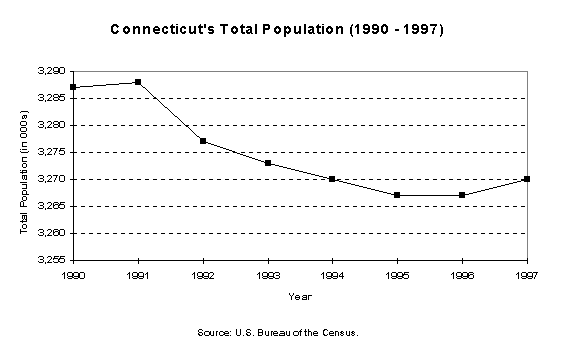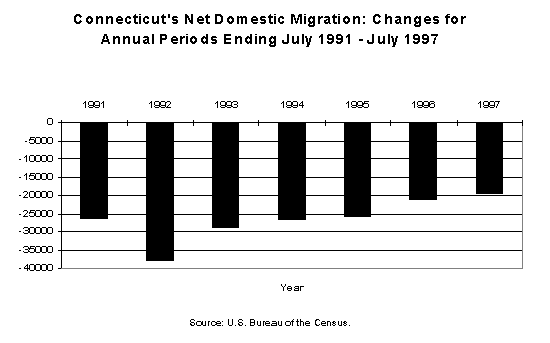
A DEMOGRAPHIC PROFILE OF CONNECTICUT POPULATION TRENDS
Connecticut's population grew by 8.4 percent from 1970 to 1990, from 3.032 million to 3.287 million residents. The state's recession, from early 1989 until late 1992, contributed to a modest population decline of .06 percent from 1990 to 1995.
Although the state's economy has improved significantly in the past five years, the state has not experienced a corresponding increase in population, which has risen only one tenth of 1 percent since the 1995 low point.

Further, despite an improved state economy, more people continue to leave rather than locate in Connecticut. The Census Bureau measures this type of positive or negative change as "net domestic migration." It represents the difference between annual population movement into and out of a particular state, where both the origin and the destination are within the United States. Connecticut's most recent net domestic migration measure is still negative, -19,371 from 1996 to 1997. However, this figure is the lowest since 1990-91. Overall, Connecticut's total outmigration from July 1990 to July 1997 was approximately 186,000.

While Connecticut's total population has stabilized since 1995, most large cities and towns continue to lose residents. Specifically, four of the five Connecticut cities with over 100,000 residents have experienced population declines since the 1990 census. Moreover, the depth of these urban losses extends to the state's mid-size towns, those with between 50,000 and 100,000 residents. Eight of the 11 mid-size towns listed below showed population declines from 1990 to 1996.
| Town | 1990 Population | 1996 Population | Percent Change |
|---|---|---|---|
| Stamford | 108,056 | 110,056 | +1.85% |
| Hamden | 52,434 | 53,332 | +1.71% |
| Fairfield | 53,418 | 53,522 | +0.19% |
| Manchester | 51,618 | 51,666 | +0.09% |
| Greenwich | 58,441 | 58,374 | -0.11% |
| Danbury | 65,585 | 65,506 | -0.12% |
| Norwalk | 78,331 | 77,977 | -0.45% |
| Bristol | 60,640 | 59,619 | -1.68% |
| Waterbury | 108,961 | 106,412 | -2.34% |
| Bridgeport | 141,686 | 137,990 | -2.61% |
| West Haven | 54,021 | 52,153 | -3.46% |
| Meriden | 59,479 | 57,189 | -3.85% |
| New Haven | 130,474 | 124,665 | -4.45% |
| Hartford | 139,739 | 133,086 | -4.76% |
| New Britain | 75,491 | 71,512 | -5.27% |
| West Hartford | 60,110 | 56,795 | -5.51% |
| Source: U.S. Bureau of the Census. | |||
In contrast, the greatest population gains since 1990 were in less populated municipalities. Among the 10 Connecticut towns with the largest rates of growth, only two had more than 10,000 residents.
| Town | 1990 Population | 1996 Population | Percent Change |
|---|---|---|---|
| Sterling | 2,357 | 2,741 | +16.29 % |
| Colchester | 10,980 | 12,620 | +14.94 % |
| Scotland | 1,215 | 1,394 | +14.73 % |
| Killingworth | 4,814 | 5,418 | +12.55 % |
| Durham | 5,732 | 6,346 | +10.71 % |
| Chester | 3,417 | 3,776 | +10.51 % |
| East Haddam | 6,676 | 7,304 | +9.41 % |
| Hebron | 7,079 | 7,744 | +9.39 % |
| Burlington | 7,026 | 7,686 | +9.39 % |
| Tolland | 11,001 | 11,994 | +9.03 % |
| Source: U.S. Bureau of the Census. | |||
Connecticut's Diversity
The state's ethnic and racial makeup is becoming increasingly diverse. From 1990 to 1996, the
state's African-American, Asian, American Indian and Hispanic populations increased steadily
despite the decrease in total population.
| Race/Ethnic Group | 1990 | 1991 | 1992 | 1993 | 1994 | 1995 | 1996 |
|---|---|---|---|---|---|---|---|
| White | 89.63% | 89.33% | 89.15% | 88.92% | 88.77% | 88.59% | 88.43% |
| Black | 8.58% | 8.74% | 8.81% | 8.92% | 8.98% | 9.03% | 9.10% |
| American Indian | 0.21% | 0.22% | 0.22% | 0.23% | 0.23% | 0.23% | 0.24% |
| Asian/Pacific Islander | 1.58% | 1.71% | 1.82% | 1.93% | 2.02% | 2.14% | 2.23% |
| Hispanic Origin* | 6.48% | 6.74% | 6.92% | 7.13% | 7.31% | 7.50% | 7.73% |
| Source: U.S. Census Bureau. *Persons of Hispanic origin can be of any race. | |||||||
An Aging Population
The state's elderly population has grown steadily throughout the 1990's. Connecticut's population
continues to increase in age faster than the national trend. In 1996, the national median age for the
United States was 34.6; Connecticut's was 36.2.
In contrast, Connecticut's under-five and 20-35 year old populations have declined each year since 1990. Since mortality rates for these population groups are low, young families represent a significant portion of the state's outmigration noted above. The table that follows shows population changes in selected age categories since 1990.
| Year | Total Population | Under Age 5 | % of Total | 20-35 Years Old | % of Total | Age 65 or Older | % of Total | |
|---|---|---|---|---|---|---|---|---|
| 1990 | 3,287 | 233 | 7.1% | 836 | 25.4% | 444 | 13.5% | |
| 1991 | 3,288 | 236 | 7.2% | 817 | 24.9% | 451 | 13.7% | |
| 1992 | 3,277 | 236 | 7.2% | 789 | 24.1% | 456 | 13.9% | |
| 1993 | 3,273 | 235 | 7.2% | 763 | 23.3% | 461 | 14.1% | |
| 1994 | 3,270 | 232 | 7.1% | 738 | 22.6% | 464 | 14.2% | |
| 1995 | 3,267 | 226 | 6.9% | 713 | 21.8% | 467 | 14.3% | |
| 1996 | 3,267 | 223 | 6.8% | 690 | 21.1% | 470 | 14.4% | |
| Source: U.S. Bureau of the Census. | ||||||||